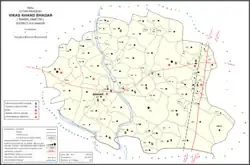Piparpur, Bhadar
Piparpur is a village in Bhadar block of Amethi district, Uttar Pradesh, India.[2] The historical capital of the pargana of Asal, Piparpur is located on the road from Amethi to Chanda, just west of the intersection with the main Allahabad-Faizabad road.[3] Running through the village is a stream that originates in the Bhujwa jhil and flows into neighbouring Prataphgarh district where it joins with the Chamraura.[3] The banks of this stream are well-wooded; they used to be more so, but a lot of it was cut down around the turn of the 20th century to provide materials for the railway.[3] There is also some significant usar land, especially in the north of the village.[3]
Piparpur
Pīparpur | |
|---|---|
Village | |
 Map showing Piparpur (#548) in Bhadar CD block | |
 Piparpur Location in Uttar Pradesh, India | |
| Coordinates: 26.135812°N 82.013129°E[1] | |
| Country | |
| State | Uttar Pradesh |
| Division | Faizabad division |
| District | Amethi |
| Area | |
| • Total | 9.70 km2 (3.75 sq mi) |
| Population (2011)[2] | |
| • Total | 6,825 |
| • Density | 700/km2 (1,800/sq mi) |
| Languages | |
| • Official | Hindi, Urdu |
| Time zone | UTC+5:30 (IST) |
Piparpur has a train station on the Faizabad-Sultanpur-Allahabad branch of the Northern Railway zone; it is located 13 km from the previous station at Sultanpur Junction and 11 km from the next station at Khundaur.[4] The station is located to the east of the village.[3]
As of 2011, Piparpur has a population of 6,825 people, in 1,022 households.[2] It has one primary school and no healthcare facilities and hosts both a permanent market and a weekly haat.[2] Besides Piparpur proper, there are also 15 dependent hamlets that are included in the village lands.[3] Piparpur serves as the seat of a nyaya panchayat which also includes 18 other villages.[5]
History
Piparpur was the capital and main settlement in the historical pargana of Asal.[3] The Piparpur railway station was built in 1901;[4] before this, its main claim to importance was as the seat of a police thana.[3] It also held a market.[3] At the turn of the 20th century, Piparpur was held in bhaiyachara tenure by a huge group of over 200 Bachgoti Rajputs along with a few Kayasths and Banias.[3] Due to conflict among the landowners, a process of partition was begun in 1902.[3] Its population as of 1901 was 1,806 people, mostly Rajputs; in addition to the Hindu population there was also a small Muslim minority of 101.[3]
The 1951 census recorded Piparpur (as "Piperpur") as comprising 16 hamlets, with a total population of 2,167 people (1,084 male and 1,083 female), in 449 households and 381 physical houses.[6] 145 residents were literate, all male.[6] The village was listed as belonging to the pargana of Asal and the thana of Piparpur.[6] Either it or the Piparpur in Bhetua block had a district board-run primary school with 120 students in attendance as of 1 January 1951.[6]
The 1961 census recorded Piparpur as comprising 16 hamlets, with a total population of 2,366 people (1,194 male and 1,172 female), in 465 households and 422 physical houses.[4] The area of the village was given as 2,519 acres.[4]
The 1981 census recorded Piparpur as having a population of 3,078 people, in 624 households, and having an area of 1,019.44 hectares.[7] The main staple foods were listed as wheat and rice.[7]
The 1991 census recorded Piparpur (as "Piper Pur") as having a total population of 4,717 people (2,391 male and 2,326 female), in 735 households and 730 physical houses.[5] The area of the village was listed as 1,017.00 hectares.[5] Members of the 0-6 age group numbered 1,008, or 21% of the total; this group was 50% male (504) and 50% female (504).[5] Members of scheduled castes numbered 508, or 21% of the village's total population, while no members of scheduled tribes were recorded.[5] The literacy rate of the village was 34% (1,023 men and 396 women, counting only people age 7 and up).[5] 1,463 people were classified as main workers (1,184 men and 279 women), while 97 people were classified as marginal workers (2 men and 95 women); the remaining 3,157 residents were non-workers.[5] The breakdown of main workers by employment category was as follows: 717 cultivators (i.e. people who owned or leased their own land); 374 agricultural labourers (i.e. people who worked someone else's land in return for payment); 3 workers in livestock, forestry, fishing, hunting, plantations, orchards, etc.; 0 in mining and quarrying; 28 household industry workers; 142 workers employed in other manufacturing, processing, service, and repair roles; 18 construction workers; 36 employed in trade and commerce; 19 employed in transport, storage, and communications; and 126 in other services.[5]
References
- "Geonames Search". Do a radial search using these coordinates here.
- "Census of India 2011: Uttar Pradesh District Census Handbook - Sultanpur, Part A (Village and Town Directory)" (PDF). Census 2011 India. pp. 243–59. Retrieved 25 December 2021.
- Nevill, H.R. (1903). Sultanpur: A Gazetteer, Being Volume XLVI Of The District Gazetteers Of The United Provinces Of Agra And Oudh. Allahabad: Government Press. pp. 160–1, 202. Retrieved 25 December 2021.
- Census 1961: District Census Handbook, Uttar Pradesh (44 - Sultanpur District) (PDF). Lucknow. 1965. pp. 128, 132, liv–lv. Retrieved 25 December 2021.
{{cite book}}: CS1 maint: location missing publisher (link) - Census 1991 Series-25 Uttar Pradesh Part-XII B Village & Townwise Primary Census Abstract District Census Handbook District Raebareli (PDF). 1992. pp. xxiv–xxviii, 150–1. Retrieved 25 December 2021.
- Census of India, 1951: District Census Handbook Uttar Pradesh (49 - Rae Bareli District) (PDF). Allahabad. 1955. pp. 102–3, 198. Retrieved 25 December 2021.
{{cite book}}: CS1 maint: location missing publisher (link) - Census 1981 Uttar Pradesh: District Census Handbook Part XIII-A: Village & Town Directory, District Rae Bareli (PDF). 1982. pp. 124–5. Retrieved 25 December 2021.